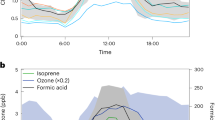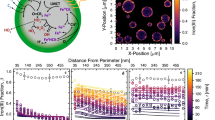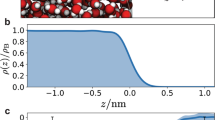Abstract
The heterogeneous reactions of O3 with aerosol particles are of central importance to air quality. They are studied extensively, but the molecular mechanisms and kinetics remain unresolved. Based on new experimental data and calculations, we show that long-lived reactive oxygen intermediates (ROIs) are formed. The chemical lifetime of these intermediates exceeds 100 seconds, which is much longer than the surface residence time of molecular O3 (~10−9 s). The ROIs explain and resolve apparent discrepancies between earlier quantum mechanical calculations and kinetic experiments. They play a key role in the chemical transformation and adverse health effects of toxic and allergenic air-particulate matter, such as soot, polycyclic aromatic hydrocarbons and proteins. ROIs may also be involved in the decomposition of O3 on mineral dust and in the formation and growth of secondary organic aerosols. Moreover, ROIs may contribute to the coupling of atmospheric and biospheric multiphase processes.
This is a preview of subscription content, access via your institution
Access options
Subscribe to this journal
Receive 12 print issues and online access
$259.00 per year
only $21.58 per issue
Buy this article
- Purchase on Springer Link
- Instant access to full article PDF
Prices may be subject to local taxes which are calculated during checkout






Similar content being viewed by others
References
Venkatachari, P. & Hopke, P. K. Development and evaluation of a particle-bound reactive oxygen species generator. J. Aerosol. Sci. 39, 168–174 (2008).
Apel, K. & Hirt, H. Reactive oxygen species: metabolism, oxidative stress, and signal transduction. Annu. Rev. Plant. Biol. 55, 373–399 (2004).
Finkel, T. & Holbrook, N. J. Oxidants, oxidative stress and the biology of ageing. Nature 408, 239–247 (2000).
Mittler, R. Oxidative stress, antioxidants and stress tolerance. Trends Plant Sci. 7, 405–410 (2002).
Pöschl, U. Atmospheric aerosols: composition, transformation, climate and health effects. Angew. Chem. Int. Ed. 44, 7520–7540 (2005).
George, I. J. & Abbatt, J. P. D. Heterogeneous oxidation of atmospheric aerosol particles by gas-phase radicals. Nature Chem. 2, 713–722 (2010).
Finlayson-Pitts, B. J. & Pitts, J. N. Chemistry of the Upper and Lower Atmosphere (Academic Press, 2000).
Seinfeld, J. H. & Pandis, S. N. Atmospheric Chemistry and Physics – From Air Pollution to Climate Change (John Wiley, 1998).
Finlayson-Pitts, B. J. Reactions at surfaces in the atmosphere: integration of experiments and theory as necessary (but not necessarily sufficient) for predicting the physical chemistry of aerosols. Phys. Chem. Chem. Phys. 11, 7760–7779 (2009).
McCabe, J. & Abbatt, J. P. D. Heterogeneous loss of gas-phase ozone on n-hexane soot surfaces: similar kinetics to loss on other chemically unsaturated solid surfaces. J. Phys. Chem. C 113, 2120–2127 (2009).
Maranzana, A. et al. Ozone interaction with polycyclic aromatic hydrocarbons and soot in atmospheric processes: theoretical density functional study by molecular and periodic methodologies. J. Phys. Chem. A 109, 10929–10939 (2005).
Pöschl, U., Letzel, T, Schauer, C. & Niessner, R. Interaction of ozone and water vapor with spark discharge soot aerosol particles coated with benzo[a]pyrene: O3 and H2O adsorption, benzo[a]pyrene degradation, and atmospheric implications. J. Phys. Chem. A 105, 4029–4041 (2001).
Kolb, C. E. et al. An overview of current issues in the uptake of atmospheric trace gases by aerosols and clouds. Atmos. Chem. Phys. 10, 10561–10605 (2010).
Rudich, Y., Donahue, N. M. & Mentel, T. F. Aging of organic aerosol: bridging the gap between laboratory and field studies. Annu. Rev. Phys. Chem. 58, 321–352 (2007).
Chu, S. N. et al. Ozone oxidation of surface-adsorbed polycyclic aromatic hydrocarbons: role of PAH–surface interaction. J. Am. Chem. Soc. 132, 15968–15975 (2010).
Nel, A. Air pollution-related illness: effects of particles. Science 308, 804–806 (2005).
Pöschl, U. Formation and decomposition of hazardous chemical components contained in atmospheric aerosol particles. J. Aerosol. Med. 15, 203–212 (2002).
Franze, T., Weller, M. G., Niessner, R. & Pöschl, U. Protein nitration by polluted air. Environ. Sci. Technol. 39, 1673–1678 (2005).
Fröhlich-Nowoisky, J., Pickersgill, D. A., Despres, V. R. & Pöschl U. High diversity of fungi in air particulate matter. Proc. Natl Acad. Sci. USA 106, 12814–12819 (2009).
Yang, H., Zhang, Y. & Pöschl, U. Quantification of nitrotyrosine in nitrated proteins. Anal. Bioanal. Chem. 397, 879–886 (2010).
Gruijthuijsen, Y. K. et al. Nitration enhances the allergenic potential of proteins. Int. Arch. Allergy Immunol. 141, 265–275 (2006).
Traidl-Hoffmann, C., Jakob, T. & Behrendt, H. Determinants of allergenicity. J. Allergy Clin. Immunol. 123, 558–566 (2009).
Ammann, M., Pöschl, U. & Rudich, Y. Effects of reversible adsorption and Langmuir–Hinshelwood surface reactions on gas uptake by atmospheric particles. Phys. Chem. Chem. Phys. 5, 351–356 (2003).
Shiraiwa, M., Garland, R. M. & Pöschl, U. Kinetic double-layer model of aerosol surface chemistry and gas-particle interactions (K2-SURF): degradation of polycyclic aromatic hydrocarbons exposed to O3, NO2, H2O, OH and NO3 . Atmos. Chem. Phys. 9, 9571–9586 (2009).
Kwamena, N. O. A. et al. Role of the aerosol substrate in the heterogeneous ozonation reactions of surface-bound PAHs. J. Phys. Chem. A 111, 11050–11058 (2007).
Lee, G., Lee, B., Kim, J. & Cho, K. Ozone adsorption on graphene: ab initio study and experimental validation. J. Phys. Chem. C 113, 14225–14229 (2009).
Lennard-Jones, J. E. Processes of adsorption and diffusion on solid surfaces. Trans. Faraday Soc. 28, 333–358 (1932).
Giordana, A. et al. Soot platelets and PAHs with an odd number of unsaturated carbon atoms and pi electrons: theoretical study of their spin properties and interaction with ozone. J. Phys. Chem. A 112, 973–982 (2008).
Stephens, S., Rossi, M. J. & Golden D. M. The heterogeneous reaction of ozone on carbonaceous surfaces. Int. J. Chem. Kinet. 18, 1133–1149 (1986).
Rogaski, C. A., Golden, D. M. & Williams, L. R. Reactive uptake and hydration experiments on amorphous carbon treated with NO2, SO2, O3, HNO3, and H2SO4 . Geophys. Res. Lett., 24, 381–384 (1997).
Sorescu, D. C., Jordan, K. D. & Avouris, P. Theoretical study of oxygen adsorption on graphite and the (8,0) single-walled carbon nanotube. J. Phys. Chem. B 105, 11227–11232 (2001).
Kutana, A. & Giapis, K. P. First-principles study of chemisorption of oxygen and aziridine on graphitic nanostructures. J. Phys. Chem. C 113, 14721–14726 (2009).
Paulot, F. et al. Unexpected epoxide formation in the gas-phase photooxidation of isoprene. Science 325, 730–733 (2009).
Ammann, M. Using 13N as tracer in heterogeneous atmospheric chemistry experiments. Radiochim. Acta 89, 831–838 (2001).
Truong, H., Lomnicki, S. & Dellinger, B. Potential for misidentification of environmentally persistent free radicals as molecular pollutants in particulate matter. Environ. Sci. Technol., 44, 1933–1939 (2010).
Harrison, M. A. J. et al. Nitrated phenols in the atmosphere: a review. Atmos. Environ., 39, 231–248 (2005).
Zhang, Y., Yang, H. & Pöschl, U. Analysis of nitrated proteins and tryptic peptides by HPLC-chip-MS/MS: site-specific quantification, nitration degree, and reactivity of tyrosine residues. Anal. Bioanal. Chem. 399, 459–477 (2011).
Walcher, W. et al. Liquid- and gas-phase nitration of bovine serum albumin studied by LC-MS and LC-MS/MS using monolithic columns. J. Proteome Res. 2, 534–542 (2003).
Baker, J., Aschmann, S. M., Arey, J. & Atkinson, R. Reactions of stabilized Criegee intermediates from the gas-phase reactions of O3 with selected alkenes. Int. J. Chem. Kinet. 34, 73–85 (2001).
Dubowski, Y. et al. Interaction of gas-phase ozone at 296 K with unsaturated self-assembled monolayers: a new look at an old system. J. Phys. Chem. A 108, 10473–10485 (2004).
Li, W., Gibbs, G. V. & Oyama, S. T. Mechanism of ozone decomposition on a manganese oxide catalyst. I. In situ Raman spectroscopy and ab initio molecular orbital calculations. J. Am. Chem. Soc. 120, 9041–9046 (1998).
Sullivan, R. C., Thornberry, T. & Abbatt, J. P. D. Ozone decomposition kinetics on alumina: effects of ozone partial pressure, relative humidity and repeated oxidation cycles. Atmos. Chem. Phys. 4, 1301–1310 (2004).
Hanisch, F. & Crowley, J. N. Ozone decomposition on Saharan dust: an experimental investigation. Atmos. Chem. Phys. 3, 119–130 (2003).
Hallquist, M. et al. The formation, properties and impact of secondary organic aerosol: current and emerging issues. Atmos. Chem. Phys. 9, 5155–5235 (2009).
Jimenez, J. L. et al. Evolution of organic aerosols in the atmosphere. Science 326, 1525–1529 (2009).
Virtanen, A. et al. An amorphous solid state of biogenic secondary organic aerosol particles. Nature 467, 824–827 (2010).
Pöschl, U. et al. Rainforest aerosols as biogenic nuclei of clouds and precipitation in the Amazon. Science 329, 1513–1516 (2010).
Kalberer, M. et al. Identification of polymers as major components of atmospheric organic aerosols. Science 303, 1659–1662 (2004).
Pöschl, U., Rudich, Y. & Ammann, M. Kinetic model framework for aerosol and cloud surface chemistry and gas–particle interactions. Part 1: General equations, parameters, and terminology. Atmos. Chem. Phys. 7, 5989–6023 (2007).
Ammann, M. & Pöschl, U. Kinetic model framework for aerosol and cloud surface chemistry and gas–particle interactions. Part 2: Exemplary practical applications and numerical simulations. Atmos. Chem. Phys. 7, 6025–6045 (2007).
Acknowledgements
This work was funded by the Max Planck Society, the Swiss National Science Foundation (Grant 130175) and the European Integrated Project on Aerosol, Cloud, Climate and Air Quality Interactions (036833-2 EUCAARI). We thank M. Birrer, T. Bartels-Rausch and M. Kerbrat for support, and the staff of the Paul Scherrer Institute accelerator facilities for providing the stable proton beams used to produce 13N with the PROTRAC facility. M.S. is supported by the Max Planck Graduate Center, Johannes Gutenberg University Mainz, the University of Tokyo, and the Ministry of Education, Culture, Sports, Science and Technology, Japan.
Author information
Authors and Affiliations
Contributions
U.P., M.A. and M.S. designed the research. M.S., Y.S., A.R. and M.A. performed tracer experiments and M.S. analysed the data. H.Y. and Y.Z. contributed to the protein studies. M.S. and U.P. conducted the kinetic modelling. M.S., U.P., M.A. and J.A. discussed the results. M.S., U.P. and M.A. co-wrote the paper.
Corresponding author
Ethics declarations
Competing interests
The authors declare no competing financial interests.
Supplementary information
Supplementary information
Supplementary information (PDF 536 kb)
Rights and permissions
About this article
Cite this article
Shiraiwa, M., Sosedova, Y., Rouvière, A. et al. The role of long-lived reactive oxygen intermediates in the reaction of ozone with aerosol particles. Nature Chem 3, 291–295 (2011). https://doi.org/10.1038/nchem.988
Received:
Accepted:
Published:
Issue Date:
DOI: https://doi.org/10.1038/nchem.988
This article is cited by
-
A critical mini-review on challenge of gaseous O3 toward removal of viral bioaerosols from indoor air based on collision theory
Environmental Science and Pollution Research (2023)
-
Reaction kinetics and interplay of two different surface states on hematite photoanodes for water oxidation
Nature Communications (2021)
-
Organic and aqueous extraction of lipids from birch pollen grains exposed to gaseous pollutants
Environmental Science and Pollution Research (2021)
-
Hygroscopic Coating of Sulfuric Acid Shields Oxidant Attack on the Atmospheric Pollutant Benzo(a)pyrene Bound to Model Soot Particles
Scientific Reports (2018)
-
Chemically different non-thermal plasmas target distinct cell death pathways
Scientific Reports (2017)



